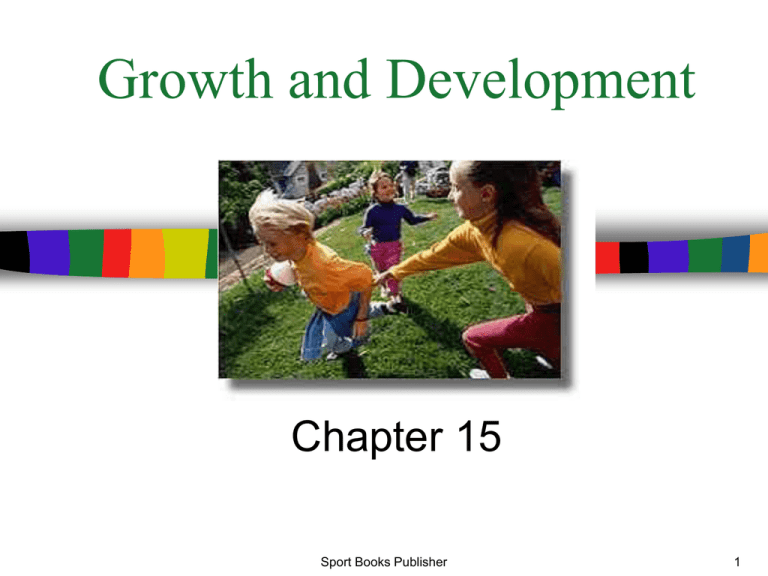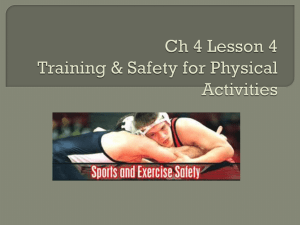
Growth and Development
Chapter 15
Sport Books Publisher
1
Learning Objectives:
Identify the stages of growth & development
Describe factors affecting growth &
development
Understand the necessity of physical activity
for optimal growth & development
Recognize and understand gender and
individual differences in growth &
development
Sport Books Publisher
2
Early Stimulation
Sport Books Publisher
3
Introduction
One must consider a few important
influences that affect individual growth
& development, including:
Early Exposure to Physical Activities
Critical Periods
Readiness
Sport Books Publisher
4
Early Exposure to Physical Activities
Encouragement to participate in various
physical activities from a young age
Early development of balance, coordination,
strength, flexibility, and endurance
Positive experiences when engaged in
physical activities
Sport Books Publisher
5
Early Exposure to Physical Activities
The benefits of early exposure to physical
activity has motivated many parents to
involve children in education programs for
many sports at a young age
Sport Books Publisher
6
Critical Periods
Times of particular sensitivity to
environmental stimuli
Potential for optimal development is
affected by the presence or absence of
appropriate stimuli at this critical period
This critical period is quite early in
development
Sport Books Publisher
7
Readiness
Implies that the individual is prepared,
or ready, to acquire a particular
behaviour or skill
Performance requires:
•
•
•
•
Desire to perform
Information
Ability
Acquisition of physical characteristics
Sport Books Publisher
8
Knowledge Check
Sport Books Publisher
9
True or False?
The
adolescent
growth spurt
occurs
approximately
two years
earlier in girls
than in boys.
Sport Books Publisher
TRUE
10
True or False?
There
is a
significant
difference
between female
and male
physique prior
to puberty.
FALSE
Sport Books Publisher
11
True or False?
Within
each of
the life stages,
there is
individuality and
variability in
growth and
development
among people
Sport Books Publisher
TRUE
12
Stages of Growth &
Development
Sport Books Publisher
13
Stages of Growth &
Development
Infancy
2. Childhood
3. Adolescence
1.
Sport Books Publisher
14
Infancy
BIRTH ONE YEAR (1)
Period of rapid growth
Males are usually heavier and taller
than females at birth
Sport Books Publisher
15
Childhood
ONE YEAR (1) ELEVEN YEARS (11)
Consists of:
• Early childhood
• Mid-Childhood
• Late Childhood
Sport Books Publisher
16
Early Childhood
One year to six years of age
Gradual loss of “baby fat”
Girls lose less fat than boys
Rapid growth but not as rapid as
infancy
Quite flexible
Muscle development while at play
Sport Books Publisher
17
Mid-Childhood
Six to ten years of age
Slower, more constant growth
Improved coordination and motor
functioning
Sport Books Publisher
18
Late Childhood
Ten to sixteen years of age
Increased rate of growth
Fat deposition just prior to adolescent
growth spurt
• 9-10 years of age in girls
• 11-12 years of age in boys
Individual differences in maturation
Sport Books Publisher
19
Late Childhood
Development of the reproductive system
Appearance of secondary sex characteristics
• Breasts
• Pubic Hair
Redistribution of body weight
• Boys - muscle tissue, body fat
• Girls - slight body fat
Sport Books Publisher
20
Late Childhood
Earlier onset of
maturation in females
may account for their
ability to achieve worldclass status across
many sports
For example, Tara
Lipinski, is the youngest
US ladies’ figure skating
champion
Sport Books Publisher
21
Adolescence
Fourteen to twenty
years of age
Following puberty
Ends with onset of
adulthood
Obvious differences in
physical growth cease
with the end of
adolescence
Sport Books Publisher
22
Adolescence
The variability of body types
(somatotypes) become more evident
• Ectomorph
• Mesomorph
• Endomorph
Usually individuals are a combination of
these body types
Sport Books Publisher
23
Somatotypes
Sport Books Publisher
24
Ectomorph
Linear shape
Delicate bone structure
Little fat
Long limbs relative to the body
Sport Books Publisher
25
Ectomorph
Sport Books Publisher
26
Mesomorph
Well-muscled
Little body fat
Broad shoulders
Narrow waist
Sport Books Publisher
27
Mesomorph
Sport Books Publisher
28
Endomorph
Rounded appearance
Heavy bone structure
Little bone and muscle definition
Sport Books Publisher
29
Endomorph
Sport Books Publisher
30
Adolescence
External social pressures for the “ideal” body type
Combined with many physical, hormonal, and
psychological changes that occur at this time
Sport Books Publisher
31
Factors Affecting Growth &
Development
Sport Books Publisher
32
Factors Affecting Growth &
Development
Large variation among individuals
A number of factors affect growth and
development, including:
• Heredity
• Nutrition
• Socioeconomic status
• Exercise
Sport Books Publisher
33
Heredity
Genetic information that
is passed on from
generation to generation
These genes are also
affected by
environmental factors
For example, malnutrition
may prevent an individual
from growing to their
maximum potential height
Sport Books Publisher
34
Nutrition
Adequate nutrients are
essential for growth &
development
Carbohydrates and fats are
primarily used for energy
Proteins contribute to the
growth and repair of body
tissues, including muscle
Vitamins, minerals and water
are also essential for various
functions and reactions that
occur in the body
Sport Books Publisher
35
Nutrition
Undernourishment or
malnutrition can
delay growth
Undernourishment
exists even in
countries with
abundant food
supplies
Overeating is also a
problem in these
countries and can
lead to obesity when
combined with a
sedentary lifestyle
Sport Books Publisher
36
Socioeconomic Status
Body size is positively
related to socioeconomic
status and may be related to
nutrition
That is, socioeconomic
status affects
• Income (money to spend on
food)
• Education (knowledge about
healthy food)
• Time (food selection and
preparation time)
• Availability (access to stores with
healthy food choices)
Sport Books Publisher
37
Socioeconomic Status
Other factors may contribute to the
differences observed in growth &
development among individuals, such
as
• Lower levels of stress;
• Better sleeping patterns; and
• Regular exercise
These factors are easier to ensure
when the basic necessities are met
Sport Books Publisher
38
Exercise
& Bone Development
Regular exercise tends to increase the
diameter and density of bone
Increased strength and durability
Increased length of non-weight bearing
bones such as the arms
Overuse injuries can be incurred by young
children who over-train
Too much strain on a bone during a period
of growth can lead to “osteochondrosis,” or
the de-arrangement of the normal process of
bone growth
Sport Books Publisher
39
Exercise
& Body Composition
Active children and
teenagers show:
An increase in lean body
mass
A decrease in percent
body fat
Muscle hypertrophy with
exercise
Sport Books Publisher
40
Exercise
& Social Development
Team sports that stress positive
interaction and cooperation facilitate
social development in children and
teens
Pressure by parents and coaches can
hinder the development of an active
lifestyle and cause stress
Sport Books Publisher
41
Perceptual Motor Development
Across the
Growth & Development Cycle
Sport Books Publisher
42
Perceptual Motor Development Across
the Growth & Development Cycle
The importance of physical education as an
integral part of the school curriculum is often
overlooked
Some parents discourage physical education
and emphasize academics
Other parents encourage physical activity
pursuits by enrolling their children in
organized physical activity programs
Sport Books Publisher
43
Perceptual Motor Development Across
the Growth & Development Cycle
“Perceptual Motor Development”:
The use of movement activities to
enhance academic or intellectual
performance
Theory developed by Kephart over 30
years ago
Sport Books Publisher
44
Kephart’s Theory of
Perceptual-Motor Development
Believed that learning deficiencies
resulted from the inability to properly
integrate present stimuli with the stored
information concerning past stimuli
Suggests that participation in basic
forms of movement may improve
reading and writing skills
Sport Books Publisher
45
Gender Body Structure
Differences Across the Growth
& Development Cycle
Sport Books Publisher
46
Stature
Refers to a person’s standing height
The distance between the floor and the
highest point on the skull
Body length is measured in infants while
the child is supine
Sport Books Publisher
47
Stature
Little difference in average length
between males and females at birth
50.5 cm (boys) vs. 49.9 cm (girls)
By the end of the first year, boys are
longer on average
75 cm (boys) vs. 73.1 cm (girls)
After 2 years, stature increases more
slowly, until adolescence
Sport Books Publisher
48
Stature
The age of onset of the adolescent
growth spurt can vary by 3+ years
Usually occurs at 10 or 11 years in girls
and at 12 or 13 years in boys
• Boys grow 10cm/year on average
•
Girls grow 8cm/year on average
Sport Books Publisher
49
Stature
Due to hormonal changes that trigger
growth to a peak height by adulthood
• Peak height achieved by 18 years in boys, on
average
• Peak height achieved by 16.5 years in girls, on
average
Usually no change in stature after age 30
Sometime after age 45, height begins to
decrease due to a degeneration of vertebral
disks
Sport Books Publisher
50
Weight
Little difference in body weight exists
between boys and girls from birth until
adolescence
Rapid weight gain occurs from birth to 6
months, such that by 5 months, an
infant can double its weight since birth
(20g/day)
Weight gain decelerates during the
second year of life
Sport Books Publisher
51
Weight
Weight gain continues for the next 3 years
(approximately 2kg/year or 4.5lbs/year)
Slight increase in rate of weight gain per
year from 6 years to adolescence
(approximately 3kg/year or 6.5lbs/year)
Sharp increase in body weight at
adolescence
• Boys gain 20kg (45lbs) on average
• Girls gain 16kg (35lbs) on average
This adolescent weight gain can be
attributed to increases in height and
changes in body composition
Sport Books Publisher
52
Gender Fitness Differences
Across the Growth &
Development Cycle
Sport Books Publisher
53
WHO
IS
MORE
FIT???
Sport Books Publisher
54
Four Components of Fitness
“Fitness” is NOT synonymous with leanness.
There are four components to fitness, including:
Cardiovascular Endurance
Body Composition
Flexibility
Muscular Strength
Sport Books Publisher
55
Cardiovascular Fitness
Sport Books Publisher
56
Cardiovascular Fitness
The
efficiency of the heart, lungs, and
vascular system in delivering oxygen
to working muscles in order to maintain
physical work
Delivery of oxygen to muscles is
affected by:
•Heart rate
•Stroke volume
•Cardiac output
Sport Books Publisher
57
Cardiovascular Fitness
Heart
Rate:
The number of times the heart
beats each minute
Boys heart rates are approximately 10%
lower than girls’ rates
Children under 6 years have an average HR
of 100 bpm (beats per minute)
The average heart rate is 72 bpm
HR increases with physical activity
Sport Books Publisher
58
Cardiovascular Fitness
Stroke Volume:
The amount of blood that is ejected
from the heart with each contraction
Stroke volume is lower in children than in adults
because children have smaller hearts
Thus, heart rate needs to be higher in children
Exercise training greatly increases stroke
volume
Females generally have a lower stroke volume
than males at rest and during exercise
Sport Books Publisher
59
Cardiovascular Fitness
Cardiac Output:
The amount of blood that can be
pumped from the heart in 1 minute
Cardiac Output = HR x Stroke Volume
C.O. is lower in children than adults
Training increases C.O.
Sport Books Publisher
60
Cardiovascular Fitness
To improve cardiovascular fitness, get into
the habit of achieving:
Repetitive motion activity that involves large
muscles
20-30 minutes of sustained activity
An increase in breathing depth and frequency
A regular schedule, 3-5 days per week
Sport Books Publisher
61
Body Composition
Sport Books Publisher
62
Body Composition
Refers to the amount of lean
body tissue (muscle and bone)
and fat in the body
Fat is stored fat cells called
adipocytes
The number of adipocytes in
the body increases during
childhood, especially during
the first year of life and during
puberty
After puberty, girls usually
have a greater percentage of
fat than boys
Sport Books Publisher
63
Body Composition
Fat is necessary for many functions,
including:
• Insulation
• Protection of internal organs
• Energy reserve for the body
Healthy and recommended body fat
content:
•
Males
•
Healthy: 10-22%
Minimal: 3-7%
Recommended: 15%
Females
Healthy: 20-32%
Minimal: 10-20%
Recommended: 25%
Sport Books Publisher
64
Body Composition
Calipers are the
instruments used to
determine body fat
There is a gradual
increase in body fat
with age
Sport Books Publisher
65
Body Composition
Women generally
accumulate more
fat than men;
distributed evenly
over the body
Men tend to
collect fat around
the trunk
Sport Books Publisher
66
Flexibility
Sport Books Publisher
67
Flexibility
The range of motion about a joint or series of
joints
Factors affecting flexibility:
• Anatomical structure of joint (bony structure, muscles,
ligaments, tendons)
• Exercise habits
• Stretching habits
• Age (natural decrease with age)
• Gender (women are generally more flexible)
Sport Books Publisher
68
Flexibility
The “stretch reflex” protects stretched muscles from
injury
Muscle spindles signal an increase in length of the
muscle when stretched
When the stretch reflex is invoked, the muscle
contracts in order to prevent over-stretching and
potential injury
Slow, gentle stretches will prevent the stretch reflex by
activating Golgi tendon organs that act in opposition
to the stretch reflex
Sport Books Publisher
69
Flexibility
Stretches that are held allow the muscle to relax and
lengthen
Stretches should cause tension but not pain within the
muscle
Warm-up prior to stretching
Hold the stretched position for 15-20 seconds
Sport Books Publisher
70
Muscular Strength
Sport Books Publisher
71
Muscular Strength
The maximum tension or force a muscle can exert in
a single contraction
Muscular strength is important because muscle
contraction allows movement to occur
Without muscular strength, a sedentary life often
results
Sport Books Publisher
72
Muscular Strength
A hand grip dynamometer is commonly used to
measure muscular strength or grip strength
The instrument is used to measure the force exerted
when a hand squeezes as hard as possible
Sport Books Publisher
73
Muscular Strength
Strength gains in adolescence are rapid for both
males and females
In females, strength begins to peak by the late teens
In males, strength begins to peak during the twenties
Difference in muscle strength in males versus females
becomes apparent after puberty
Testosterone is responsible for increases in
muscularity and exists in smaller amounts in women
compared to men
Thus, women tend to develop less muscle and more
body fat as adults
Strength peaks between 20-30 years of age and then
slowly declines with age in both sexes
Sport Books Publisher
74
Muscular Strength & Strength Training
Resistance training with weights
increases muscular strength
Significant strength gains can be
achieved in prepubescent
individuals with resistance training
Weight-lifting is NOT
recommended for prepubescent
children
Regular strength training can slow
the decline in strength seen with
age in both men and women
Strength training practiced
regularly throughout adulthood can
increase mobility and
independence when elderly
Sport Books Publisher
75
Social and Psychological Factors
Across the Growth & Development
Cycle
Sport Books Publisher
76
Self-Esteem and Self-Concept
Self-Esteem: the value we place on ourselves as
persons
Self-Concept: the perception that we have of
ourselves
Athletic Competence: a perceived level of success in
competitive sporting activities
Involvement in physical activity has been shown to
enhance self-esteem and self-concept
Athletic competence is not necessary to achieve the
self-esteem benefits of physical activity
Though athletic competence can have a positive
effect on self-esteem in itself
Sport Books Publisher
77
Social Influences
Family
Social
Influences
Sport Books Publisher
Peers
78
Family
Family influences children’s choice to participate in
physical activities and the success attained
Parents’ approval or disapproval of physical activity
impacts the child’s future involvement in sports
The family’s views concerning physical activity are
instilled at a young age
Sport Books Publisher
79
Peers
As adolescence approaches, the family’s influence
diminishes
The peer group becomes an important social force
The need for peer approval can affect decisions
concerning participation in physical activity positively
or negatively
Sport Books Publisher
80
Youth Sports
Sport Books Publisher
81
Why Children Participate in Sports
Children have cited many reasons for sport
participation. Of these, which is the most
important to them?
To improve skills
To have fun
To be with friends
To be part of a team
To experience excitement
To receive awards
To win
To become more physically fit
Sport Books Publisher
82
Why Children Drop Out of Sports
Interpersonal problems (disliking the coach or peers)
To pursue other leisure activity interests
To become involved in a different sport activity
Excessive stress
It is more common for children to drop out due to
interpersonal problems than due to excessive stress.
Sport Books Publisher
83
Youth Sport Coaching
It is important to offer youth sport programs that are
led by competent coaches
Too often, coaches are volunteers or parents and
have little formal training
Coaches should be encouraged to become certified
prior to coaching
Children’s first experiences in organized sport should
be positive in order to develop healthy attitudes
towards sports and physical activity
Sport Books Publisher
84





